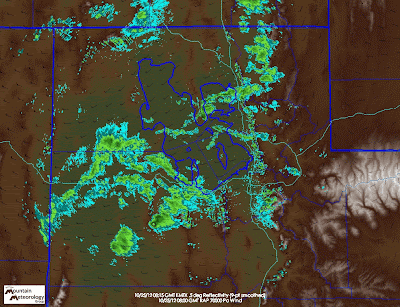Like a vampire, the Great Salt Lake Effect does not like the sun. Yesterday's event provided a marvelous example of how lake effect tends to weaken during the day. Note in the loop below how the lake effect is well organized during the morning, but falls apart and is replaced by scattered snow showers that form all over northern Utah during the afternoon.
Just to drive that point home, the images below show the transition from coherent, organized lake effect in the morning [1600 UTC (10 AM MDT)] to scattered snow showers in the afternoon [2100 UTC (3 PM MDT)].
This daily modulation shows up very well in the Great Salt Lake effect climatology. As shown by
Alcott et al. (2012), the Great Salt Lake effect is far more common from sunset to just after sunrise than it is during the afternoon. This effect is strongest during the spring, when the days are long and the sun angle high, than during the winter, when the days are short and the sun angle low.
 |
| Source: Alcott et al. (2012) |
In addition, Great Salt Lake effect events are more likely to start at night and end during the day.
 |
| Source: Alcott et al. (2012) |
To understand this daily modulation, you need to abandon the conventional wisdom that lake effect is caused simply by the atmosphere picking up water vapor over the Great Salt Lake. That can be a contributing factor, but it is the heating of the atmosphere when cold air moves over the relatively warm Great Salt Lake that is critical for lake effect. This heating has two effects. First, it destabilizes the atmosphere. Second, it induces a pressure trough, which contributes to the development of offshore flow and low-level convergence over the Great Salt Lake. This thermally driven convergence helps to initiate and organize lake-effect snow showers.
 |
| Source: The COMET Program |
During the day, however, the air is not only warmed over the Great Salt Lake, but also by heating over the surrounding land surface. This destabilizes the atmosphere over the land and weakens the temperature contrast between the lake and the land. As a result, the thermally driven convergence weakens. Sometimes the air over the land becomes warmer than over the lake, and the low level flow over the lake diverges, which is especially bad news for lake effect.
Therefore, daytime heating frequently results in a transition from lake-effect precipitation, which falls primarily over and downstream of the Great Salt Lake, to scattered snow showers, which fall all over northern Utah. While lake effect can sit in one place and produce a significant accumulation, scattered snow showers typically move around a lot and don't yield large accumulations. Because of the influence of day length and sun angle, this daily modulation of lake-effect is typically strongest in the spring and weakest in the winter (lake effect is rare in the summer).
Of course, there are exceptions. There are some lake-effect events that do start or rage on during the afternoon. An example is the lake-effect band of November 25, 2001, which contributed to the "Hundred Inch Storm" and was fully developed at 2340 UTC (440 PM MST).
However, this was an event with widespread snow cover that occurred within a month of the winter solstice, which likely led to minimal daytime surface heating over land.
The bottom line is that the Great Salt Lake effect is a nocturnal creature, that only under the right conditions does it make an appearance in the afternoon.























































